
| Click on the image above to go to the exhibition's website in a new window |
| Discover the allure of the ancient Egyptians and their quest to achieve immortality in an exhibition featuring the largest selection of antiquities ever loaned by Egypt for display in North America. More than 100 treasures from the resting places of kings and nobles—massive stone carvings, intricately painted coffins, gold death masks, and stunning glassware—provide a glimpse into a fascinating society. The Quest for Immortality: Treasures of Ancient Egypt is one of the largest and most elaborate traveling exhibitions the Museum has ever hosted. Artifacts from the Egyptian Museum in Cairo, the Luxor Museum, and the sites of Tanis and Deir el-Bahari, many never before seen outside of Egypt, showcase the period of the New Kingdom (1550–1069 BCE) through the Late Period (664–332 BCE). Exhibition Highlights A life-size reconstruction of the burial chamber of the New Kingdom pharaoh Thutmose III, ruler of Egypt An eight-foot-long wooden model of a pharaoh’s river ship, painted with scenes of the Egyptian god Montu A sculpture of the god Osiris, wrapped as a mummy, depicted in the process of rising |
| Images and information from items in the exhibit |
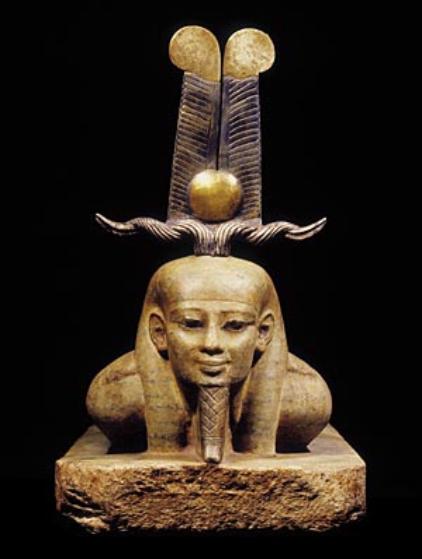
| Osiris rising This sculpture of a mummified figure depicts the goal of every Egyptian—to become Osiris at the moment of rebirth. Twenty-sixth Dynasty, 664–525 BCE Gneiss, with electrum and gold headdress The Egyptian Museum, Cairo |

| Bronze cat Cats were common companions in ancient Egypt, and also excellent hunters who kept homes, temples, and storehouses free of rodents. Late Period to Ptolemaic Period, ca. 664–30 BCE Bronze The Egyptian Museum, Cairo |

| Thoth and Maat Composite statues like this often showed Thoth with a worshipper facing him and were donated to temples to demonstrate devotion to the god. Late Period, 664–332 BCE Wood and bronze The Egyptian Museum, Cairo |

| Maat, goddess of order, truth, and justice The heart of a deceased person was weighed against the feather of Maat during judgment in the underworld. Third Intermediate Period, ca. 800–700 BCE From Khartoum, Sudan Gold and lapis lazuli The Egyptian Museum, Cairo |

| Falcon-headed god Horus Like the falcon, the god Horus—son of Osiris and a protector of the pharaohs—was a great hunter and powerful adversary. Twenty-second Dynasty, ca. 945–715 BCE Bronze with gold inlay The Egyptian Museum, Cairo |
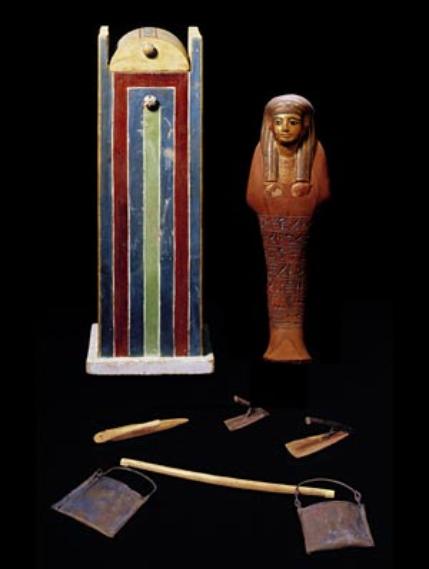
| Ushebti of Yuya The ushebti—one who answers—was believed to awaken magically and perform any labor required of the tomb owner in the next life. Eighteenth Dynasty Reign of Amenhotep III, 1390–1352 BCE From Thebes, Valley of the Kings, Yuya and Tuya’s tomb Painted wood The Egyptian Museum, Cairo |
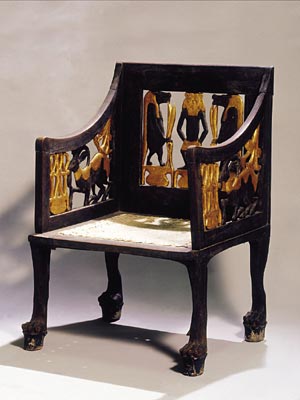
| Child’s chair This chair, showing the god Bes, protector of women and children, was probably made for Yuya and Tuya’s granddaughter, Princess Sit-Amun. Eighteenth Dynasty Reign of Amenhotep III, 1390–1352 BCE From Thebes, Valley of the Kings, Yuya and Tuya’s tomb Wood and gold The Egyptian Museum, Cairo |
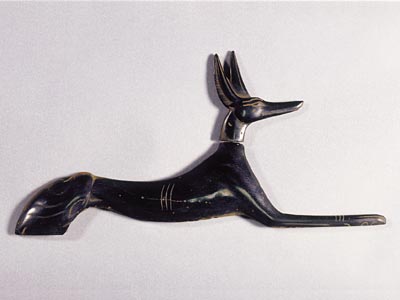
| Jackal Anubis, the god of mummification, is often depicted as a black jackal— common in ancient Egypt—guiding the dead through the underworld. Late Period, 664–332 BCE Glass The Egyptian Museum, Cairo |

| Senet game The goal of the popular—and spiritually significant—game Senet was to be the first to move your pieces across and off the board. Seventeenth Dynasty, ca.1600 BCE From Thebes, Dira Abu el-Naga, tomb of Akhor Ebony, ivory, and faience The Egyptian Museum, Cairo |
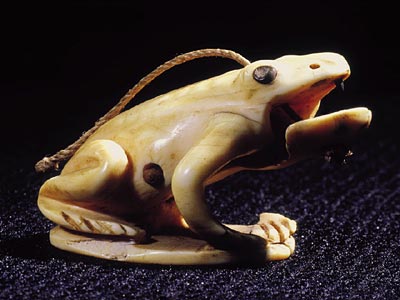
| Ivory frog This frog may have been more than just a toy, since frogs were associated with fertility, creation, and regeneration. New Kingdom, 1550–1069 BCE Ivory The Egyptian Museum, Cairo |

| Hounds and Jackals playing set This is an incomplete set of pieces belonging to a game for which the rules are unknown. Seventeenth Dynasty, ca. 1580–1550 BCE or later From Thebes, Dira Abu el-Naga, tomb of Neferhotep Wood The Egyptian Museum, Cairo |
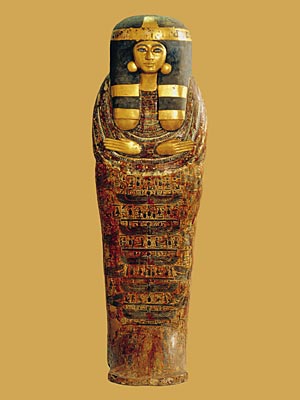
| Coffin of Princess Isis-em-akhbit Due to tomb raiding, priests reburied Princess Isis-em-akhbit in a mass grave along with the mummies of forty other kings, queens, and nobles. Twenty-first Dynasty Reign of Psusennes II, 959–945 BCE From Thebes, Deir el-Bahari, Cachette of Royal Mummies Painted wood and gold The Egyptian Museum, Cairo |

| Mummy on bier This statuette shows the deceased’s ba, or soul, as a human-headed bird resting its arms protectively upon the mummy. Eighteenth Dynasty Reign of Thutmose IV and Amenhotep III, 1400–1352 BCE From Thebes Granodiorite The Egyptian Museum, Cairo |

| Block with relief of Nebnefer This sculpture, with the goddess Hathor on the front, Nebnefer kneeling on the side, and two crocodiles on top, was dedicated to the crocodile god Sobek. Eighteenth Dynasty Reign of Amenhotep III, 1390–1352 BCE From Dahamsha, Sobek Temple Granodiorite The Luxor Museum |

| Ushebti box of Djed-Maat-iuesankh The 401 small ushebti figures kept in this box would have accompanied their mistress to the afterlife, awakening when their services were required. Twenty-first to Twenty-second Dynasties, 1069-715 BCE Painted wood The Egyptian Museum, Cairo |

| Anthropoid coffin of Paduamen, with inner board and lid Coffins that contained mummies evolved from simple, rectangular forms to very elaborate and richly detailed designs, as seen with Paduamen’s coffin. Twenty-first Dynasty Reign of the High Priest Pinudjem II, 1069–945 BCE From Deir el-Bahari, tomb of Bab El- Gusus Painted and varnished wood The Egyptian Museum, Cairo |

| Headrest Designed to support the neck, this typical headrest would have been padded with a linen cushion when used in life. Late Old Kingdom–First Intermediate Period, ca. 2345–2055 BCE Alabaster or travertine The Egyptian Museum, Cairo |
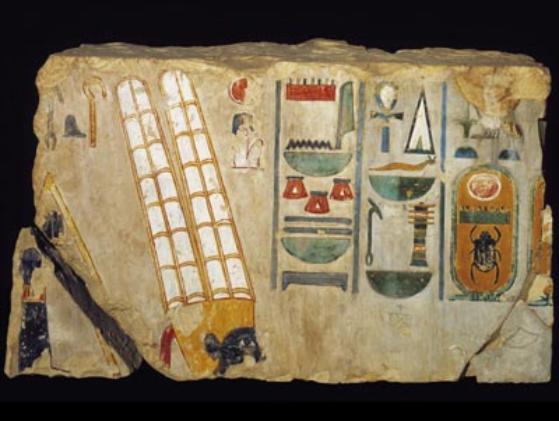
| Relief of Amun This two-foot fragment of painted wall came from a temple built by Thutmose III to honor Amun-Re as a fertility deity. Eighteenth Dynasty, reign of Thutmose III, 1479–1425 BCE From Djeser-Akhet Temple Limestone Supreme Council of Antiquities, Deir el- Bahari |

| Amuletic plaque of Maat The two feathers this figure holds identify her as Maat, goddess of truth and justice. It would have been placed below the breast of a mummy. Twenty-first Dynasty, 1000 BCE From Sakkara Gold The Egyptian Museum, Cairo |
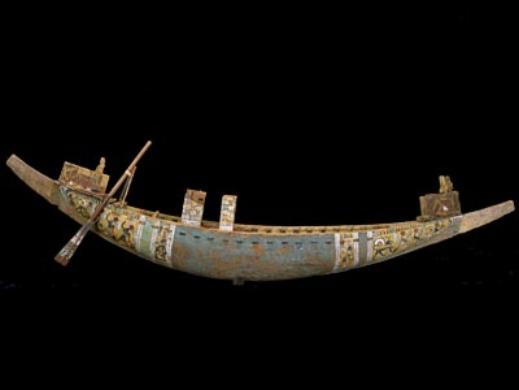
| Boat from Tomb of Amenhotep II After a king’s death, a model ship buried with him was believed to magically transform into a “solar boat” to carry him along the underworld Nile. Eighteenth Dynasty Reign of Amenhotep II, 1427–1400 BCE From Thebes, Valley of the Kings Painted wood The Egyptian Museum, Cairo |

| Head of Thutmose I This head is a fragment from one of 36 colossal statues of the deified king Thutmose I at the Temple of Karnak in Thebes. Eighteenth Dynasty Reign of Thutmose I, 1504–1492 BCE From Thebes, Temple of Karnak Painted sandstone The Egyptian Museum, Cairo |

| Sphinx of Thutmose III The form of the sphinx, combining the head of a king with the body of a lion, symbolized the pharaoh’s strength and valor. Eighteenth Dynasty Reign of Thutmose III, 1479–1425 BCE From Thebes, Temple of Karnak Granodiorite The Egyptian Museum, Cairo |

| Thutmose III Thutmose III’s stepmother, Hatshepsut, ruled Egypt after his father, Thutmose II, died— forcing him to wait many years before assuming the throne. Eighteenth Dynasty Reign of Thutmose III, 1479–1425 BCE From Thebes, Temple of Karnak Red granite The Egyptian Museum, Cairo |

| Sarcophagus lid of Nitocris Princess Nitocris is depicted lying on the lid of her coffin in a style typical of the Twenty-sixth Dynasty. Twenty-sixth Dynasty, 664–525 BCE From Thebes, Deir el-Medina Red granite The Egyptian Museum, Cairo |

| Colossal head of Ramses II The great pharaoh Ramses II left more monuments bearing his name or likeness than any other Egyptian ruler. Nineteenth Dynasty Reign of Ramses II, 1279–1213 BCE From Memphis Red granite The Egyptian Museum, Cairo |
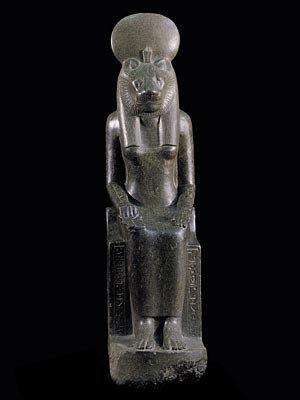
| Seated statue of Sakhmet The lioness-headed goddess Sakhmet, called “the mistress of fear,” was believed to have control over good and bad fortune. Eighteenth Dynasty Reign of Amenhotep III, 1390–1352 BCE From Thebes, Temple of Mut at South Karnak Granodiorite The Egyptian Museum, Cairo |

| Amenhotep, son of Hapu, as a scribe Because scribes were powerful and respected, Egyptian officials often chose to portray themselves in this deceptively humble pose. Eighteenth Dynasty Reign of Amenhotep III, 1390–1352 BCE From Thebes, Temple of Karnak Granodiorite The Egyptian Museum, Cairo |

| Stele of Nebnakht and family This stele, or carved stone slab, was discovered in the priest Nebnakht’s funerary chapel in 1921. Early Eighteenth Dynasty, 1550–1458 BCE From Sedment el-Gebel Painted limestone The Egyptian Museum, Cairo |

| Senenmut and Nefrure Senenmut was the architect of the female pharaoh Hatshepsut’s famous funerary temple, and tutor of her daughter, Nefrure. Eighteenth Dynasty Reign of Hatshepsut, 1473–1458 BCE From Thebes, Temple of Karnak Granodiorite The Egyptian Museum, Cairo |

| False door from the tomb of Puyemre A false door was set into the western wall of a tomb so that the deceased person’s spirit could come and go. Eighteenth Dynasty Reign of Hatshepsut/Thutmose III, 1479–1425 BCE From Thebes, el-Khokha Red granite The Egyptian Museum, Cairo |

| Pyramidion of Amenhotep-Huy The term pyramidion can mean the topmost part of an obelisk or, as in this case, the crowning feature of a tomb. Nineteenth Dynasty Reign of Ramses II, 1279–1213 BCE From Sakkara Granodiorite The Egyptian Museum, Cairo |
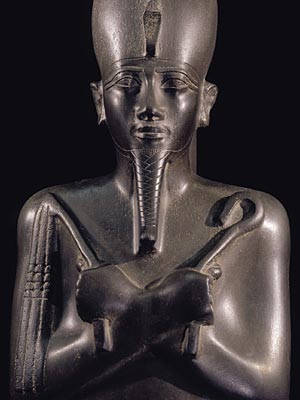
| Statue of Osiris, lord of the afterlife This statue has the identifying characteristics of Osiris, god of the afterlife. The body seems unformed, but is meant to represent a mummy. Twenty-sixth Dynasty Reign of Psamtik I, 664–610 BCE From Thebes, Medinet Habu Graywacke The Egyptian Museum, Cairo |
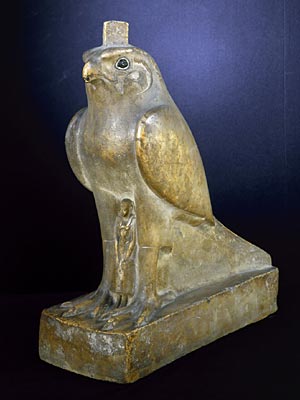
| Falcon with king Archaeologists believe this statue represents King Nectanebo II, who commissioned many statues of himself with a falcon and was worshiped as a falcon deity. Thirtieth Dynasty Reign of Nectanebo II, 360–343 BCE Limestone The Egyptian Museum, Cairo |

| Canopic chest of Queen Nedjmet Anubis, god of embalming and mummification, sits atop this chest. Four canopic jars holding Queen Nedjmet’s organs would have been within. Late Twentieth Dynasty, c. 1087–1080 BCE From Thebes, Deir el-Bahari Gilded and painted wood The Egyptian Museum, Cairo |
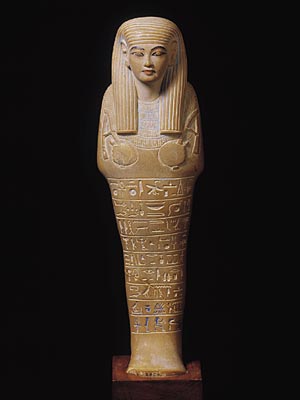
| Funerary figure of the Adjutant Hat During the time when Akhenaten rejected the old gods and embraced the Sun god Aten, this figure was made for a military assistant named Hat. Eighteenth Dynasty Reign of Akhenaten/Tutankhamun, ca. 1352–1327 BCE From Tuna el-Gebel Limestone The Egyptian Museum, Cairo |
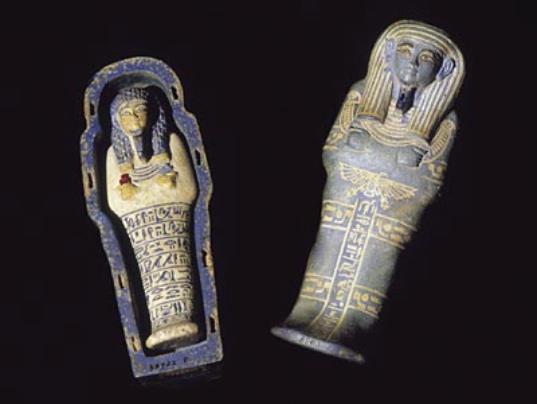
| Ushebti of Huy This ornate ushebti—one who answers—includes its own sarcophagus, and holds a red tyet knot in one hand and a djed pillar in the other. Eighteenth Dynasty Reign of Amenhotep III, 1390–1352 BCE From Abydos Polychrome faience The Egyptian Museum, Cairo |
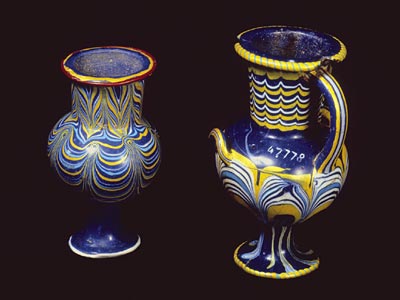
| Glass vessels These small, brilliantly colored glass vessels probably held ointments or perfumes. Eighteenth Dynasty, ca. 1400–1300 BCE From Sakkara Polychrome glass The Egyptian Museum, Cairo |

| Mirror of Queen Ahhotep In 1859, Egyptian laborers discovered this mirror, pieces of jewelry, and fans belonging to Queen Ahhotep. Eighteenth Dynasty Reign of Ahmose I, 1550–1525 BCE From Thebes, Dira Abu el-Naga Gold, bronze, and cedar The Egyptian Museum, Cairo |

| Nine gold gods The gods depicted in these sculptures are Uraeus (cobra), Bes, Ptah, Sobek, Isis, Hathor, Amun, Ptah, and Patek. New Kingdom to Ptolemaic Period, 1500–30 BCE Gold The Egyptian Museum, Cairo |

| Wedjat eye plaque Found covering the embalming incision on King Psusennes I’s mummy, the wedjat eye of Horus pronounced the mummy healthy and complete. Twenty-first Dynasty Reign of Psusennes I, 1039–991 BCE From Tanis, tomb of Psusennes I Gold The Egyptian Museum, Cairo |

| Canopic jars of Prince Hornakht The Four Sons of Horus depicted on the stoppers of these canopic jars served to protect the treated and wrapped organs they stored. Twenty-second Dynasty Reign of Osorkon II, 874–850 BCE From Tanis, tomb of Osorkon II Alabaster The Egyptian Museum, Cairo |

| Necklace with pendant in the form of Isis Because Isis, wife of Osiris and mother of Horus, is associated with regeneration, she is often featured on funerary items, like this gold necklace. Twenty-first Dynasty, ca. 1069–945 BCE From Tanis, tomb of Psusennes I Gold The Egyptian Museum, Cairo |

| Mask of Wenudjebauendjed Wenudjebauendjed, a powerful military leader, was buried with this gold funerary mask in the pharaoh’s tomb alongside his master. Twenty-first Dynasty Reign of Psusennes I, 1039–991 BCE From Tanis, tomb of Psusennes I Gold The Egyptian Museum, Cairo |
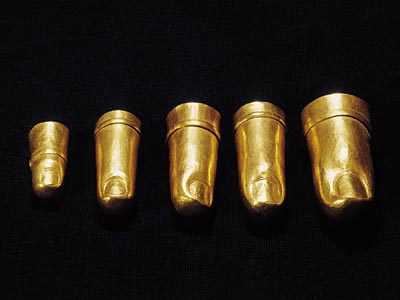
| Toe stalls of Psusennes I In the New Kingdom, the fingers and toes of royal mummies were sheathed with gold coverings, or stalls, to protect the small, brittle bones. Twenty-first Dynasty Reign of Psusennes I, 1039–991 BCE From Tanis, tomb of Psusennes I Gold The Egyptian Museum, Cairo |
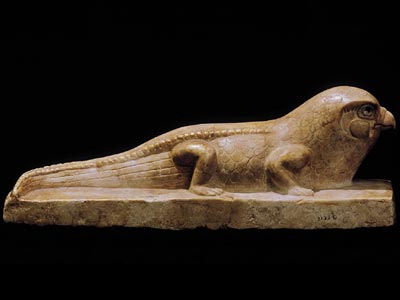
| Falcon-headed crocodile This statue combines attributes of two great hunters—the keen-eyed falcon and the mighty Nile crocodile. Late Period, 664–332 BCE From Mansoora Indurated limestone The Egyptian Museum, Cairo |
| Rand African Art home page |
